Boba Shop Case Study: Pearl Lemon Boba
Pearl Lemon Catering’s second major project was building and designing Pearl Lemon Boba (located in Fulham). This bubble tea shop had to be built 100% from scratch. This would include legal forms, finding contractors, designing menus and the shop, marketing and more.
Pearl Lemon Boba was built and launched two months after Pearl Lemon Cafe, so they have a very shared foundational story.
As our first cafe build, there were plenty of learning opportunities along the way, with things both done very right and with room to improve—making Pearl Lemon Cafe the best team that could help with a coffee consulting project; we have seen it all and then some.
The owners were from the UK (Deepak) and Southern France (Axel). Their goal was to have a lemon-based theme, especially colour-wise, pictures, and dispensers to fit the overall Pearl Lemon brand image.
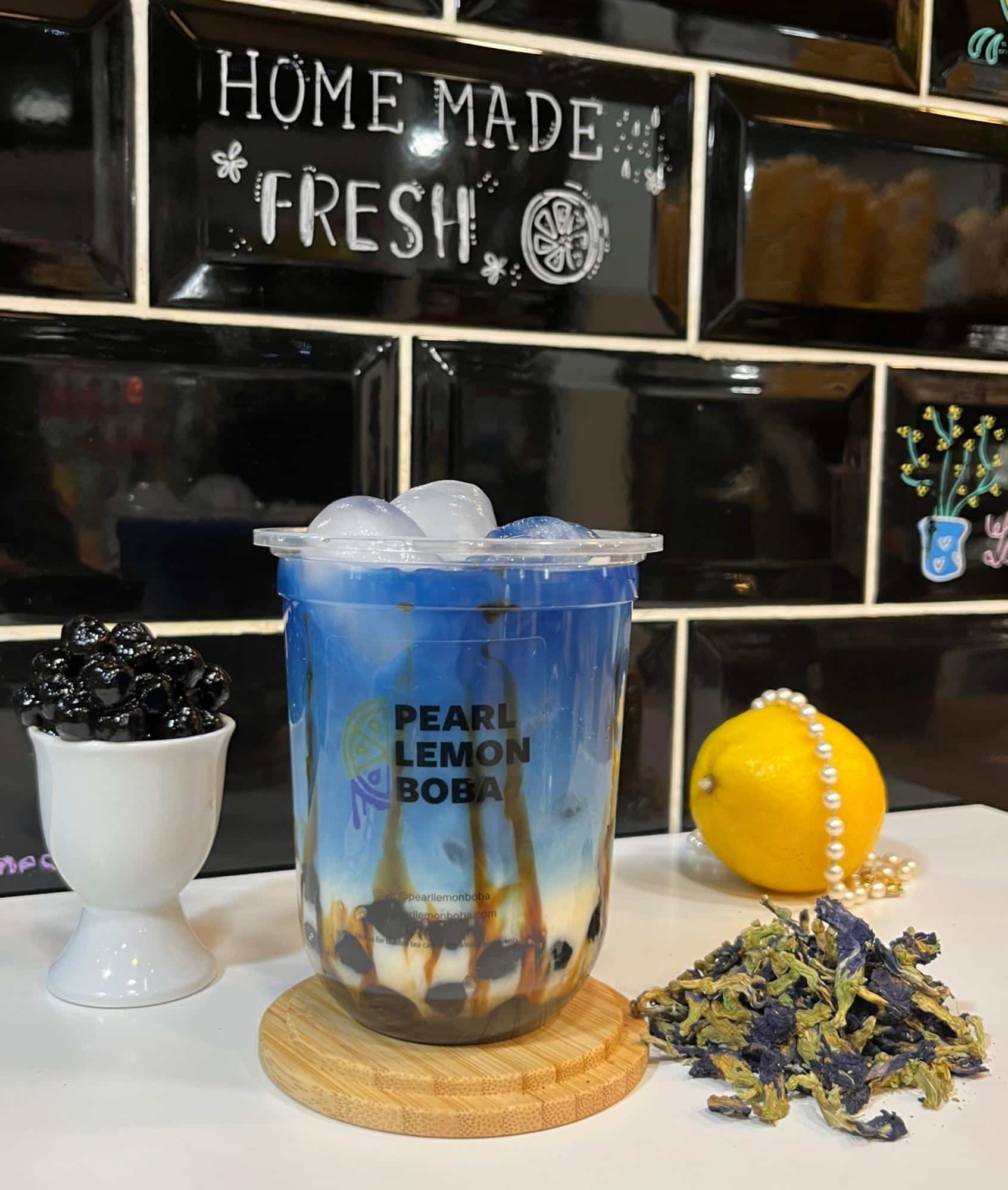
The Scope of Work
With a budget of £20,000, the Pearl Lemon Boba bubble tea shop project had to be done affordably but as high-end as possible. This cost would include designing the cafe and purchasing equipment and initial supplies.
The goal was to have a boba shop that embodied the bright lemon yellow Pearl Lemon as a company keeps while maintaining a chill space where people could grab a milk tea or sit at the cafe
The fundamental idea is it’s a reflection of the Pearl Lemon company ethos >
Young, vibrant, energetic and full of energy and life
This location was brought to us by the landlords and is across the hall from the main cafe.
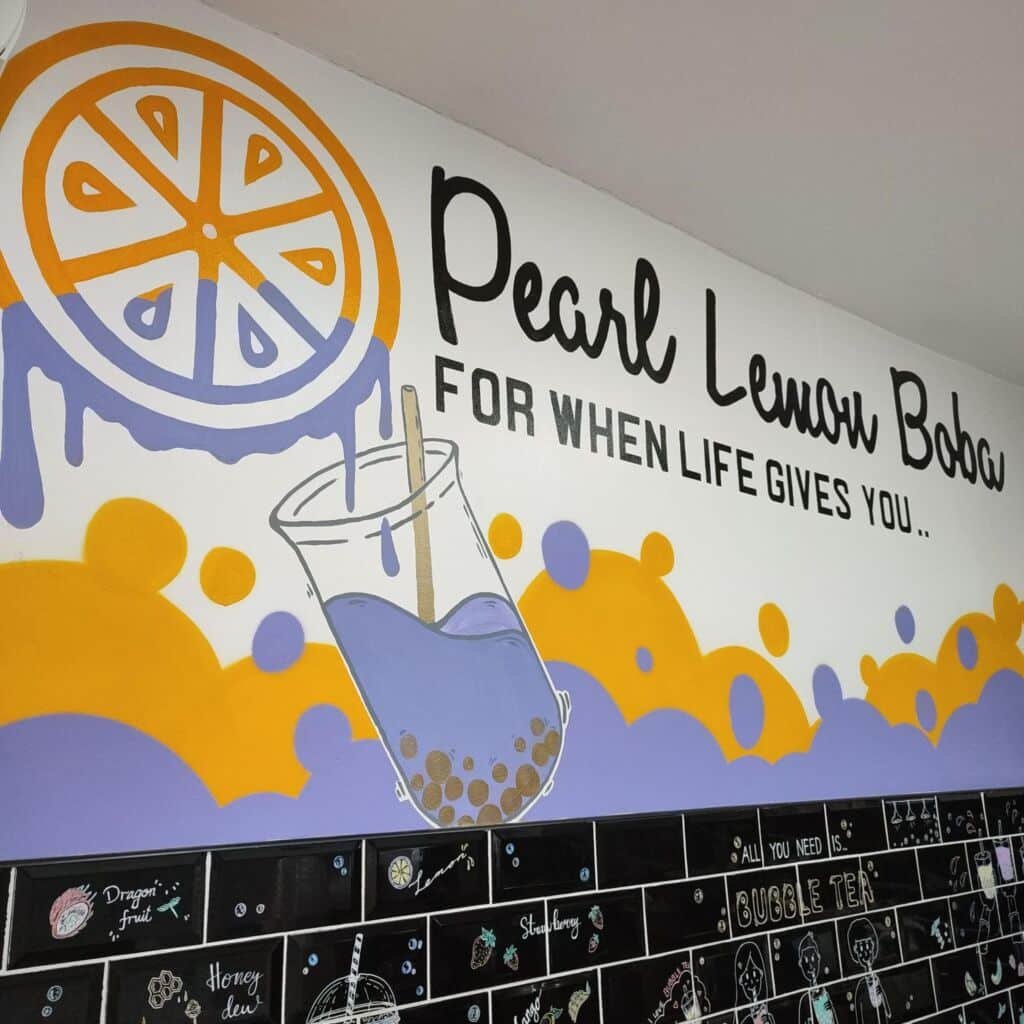
This project included the following:
- Finding a location
- Negotiating rental price
- Getting the food hygiene rating
- Applying for a food business to be registered in Fulham
- Setting up supplier relationships
- Placing initial orders
- Equipment research and ordering
- Finding contractors to paint and help make the space pretty
- Marketing
- Delivery platform set-up
- And more…
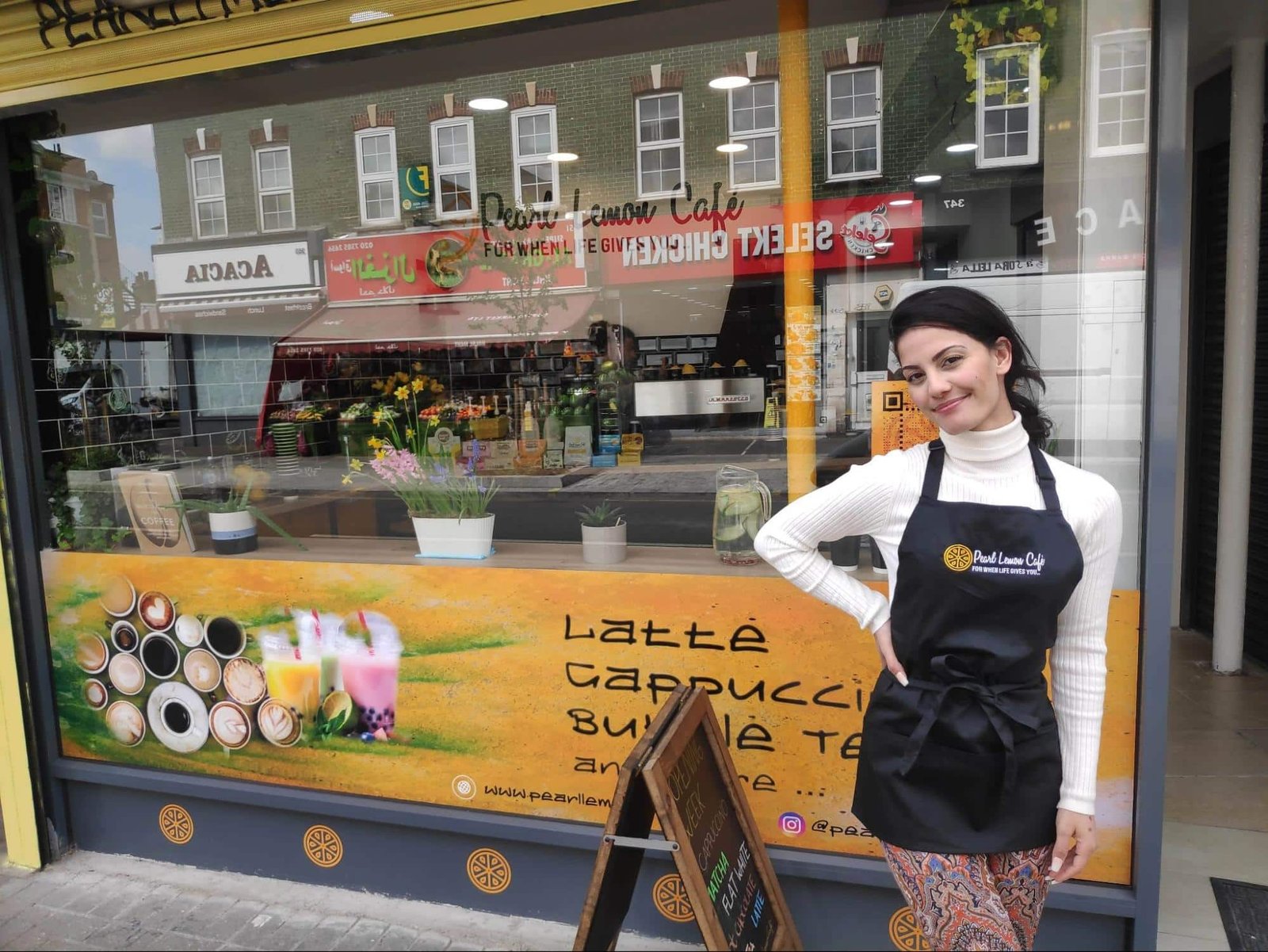
Costing the Ingredients and Equipment
Finding the right equipment and ingredient suppliers was one of the tougher parts of getting Pearl Lemon Boba started. We had to do much research to ensure we were getting good quality without spending too much too fast.
As we worked on growing Pearl Lemon Boba, we tried many different suppliers. Our goal was to find ones that offered vegan and gluten-free options without sugar and artificial ingredients.
Boba Box became a key supplier for us. They had the specialized boba ingredients we needed, like vegan and gluten-free options, which set them apart from broader marketplaces like Amazon. While Amazon was useful for some purchases, Boba Box provided the niche products and industry expertise we needed.
For equipment, we found eBay to be a great resource. Sellers there offered competitive prices and affordable shipping, making it a good option for us to get the specialized boba tea equipment we needed without overspending. This approach helped us try different machines until we found exactly what worked for our business.
Choosing suppliers and equipment evolved with our business. It was important that our suppliers could keep up with our demand for high-quality, healthier options. This careful selection process has been key to offering a standout menu in London’s boba tea scene.
In the end, working with suppliers like Boba Box for ingredients and using eBay for equipment allowed us to stick to our budget while maintaining the quality and ethics of our brand. This strategy has been crucial in providing a top-notch boba tea experience that’s health-conscious and environmentally friendly.
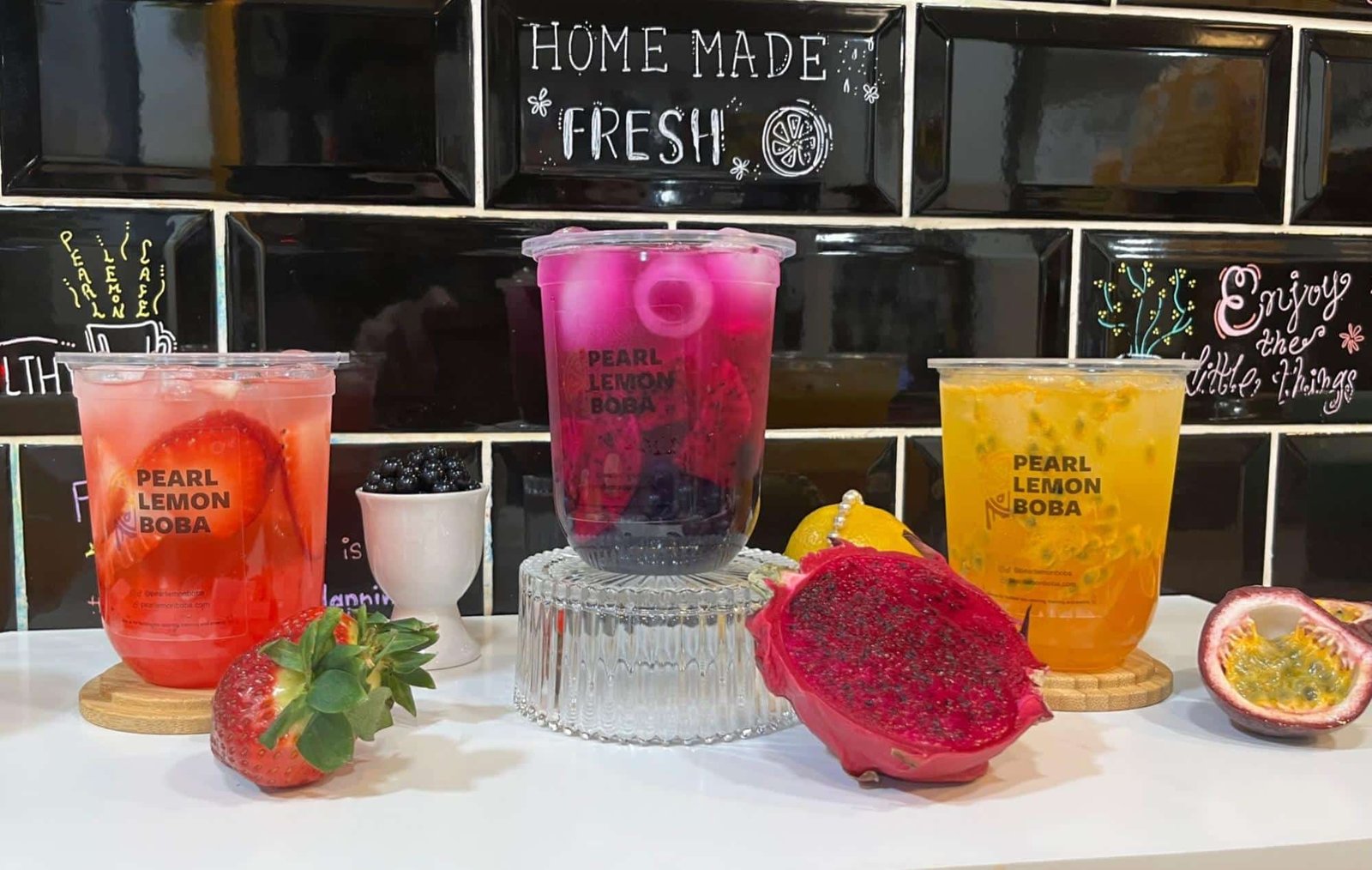
Boba Testing
Our team quickly discovered during testing that many boba places offer sugary milk or syrupy water. Milk teas lack flavour and pack a mean sugar punch, while fruit teas taste like sweetened water. We wanted to avoid this, as we didn’t want our customers to feel as disappointed as we did when sampling the competition.
We used this as our inspiration for our bubble tea menu design.
We knew we wanted lower sugar and sweetness without feeling like candy, flavour and REAL ingredients. We also wanted all flavours of milk tea to be vegetarian friendly with an ability to make it vegan and all fruit tea to be vegan automatically.
Starting this process, we focused on finding boba pearls, popping pearls, mixes, and syrups that met our specific requirements.
We tested six different brands of tapioca pearls to find ones that wouldn’t break during shipping, kept their shape, and had a good texture. For popping pearls, we found the right ones after trying two different brands. The first brand’s pearls were shriveled, stuck to teeth, and lacked the fresh pop we were aiming for. We also tried three brands of boba powder before selecting one that wasn’t too high in sugar and didn’t leave an odd, sediment-like texture in the drink, even with the use of an automatic shaker.
Finding the right fruit tea syrups was a bit of a challenge as well. We wanted syrups that had a true fruit taste, contained real fruit juice, and didn’t overwhelm with sweetness. After testing a few, we finally found the syrups that met our criteria.
Overall, it took two months of trying different products and comparing them to what was available on the market. We went through kilograms of ingredients, testing each one to make sure they lived up to our standards for quality and taste. This period of trial and error was crucial. By the end of it, we had gathered all the right raw products to start creating our recipes, ensuring that our boba drinks would stand out for their quality and flavor.
Designing the Menu
Designing our menu was a critical and engaging step in the initial setup. Our goal was clear: to merge the traditional with the innovative, introducing a few distinctive offerings that would make Pearl Lemon Boba stand out. Among our offerings, we have a list of crowd-pleasers.
Incorporating local produce and collaborating with nearby shops was a strategic move to enhance affordability and sustainability. It also served as a means to support our local community. Consequently, our menu is a blend of beloved classics and unique flavors that cater to a wide range of tastes. Essentials like brown sugar boba, Thai tea, and fruit flavors such as mango and strawberry were non-negotiable. However, we wanted to introduce something different, so we added unique twists with matcha, blue calm, and lemon.
A significant amount of time was invested in placing demo orders for testing purposes. This step was crucial, as it allowed us to tweak and perfect our recipes meticulously. Through this process, we were able to ensure each drink met our high standards for taste, quality, and originality, ultimately creating a menu that reflects Pearl Lemon Boba’s commitment to innovation and excellence in the boba tea market.
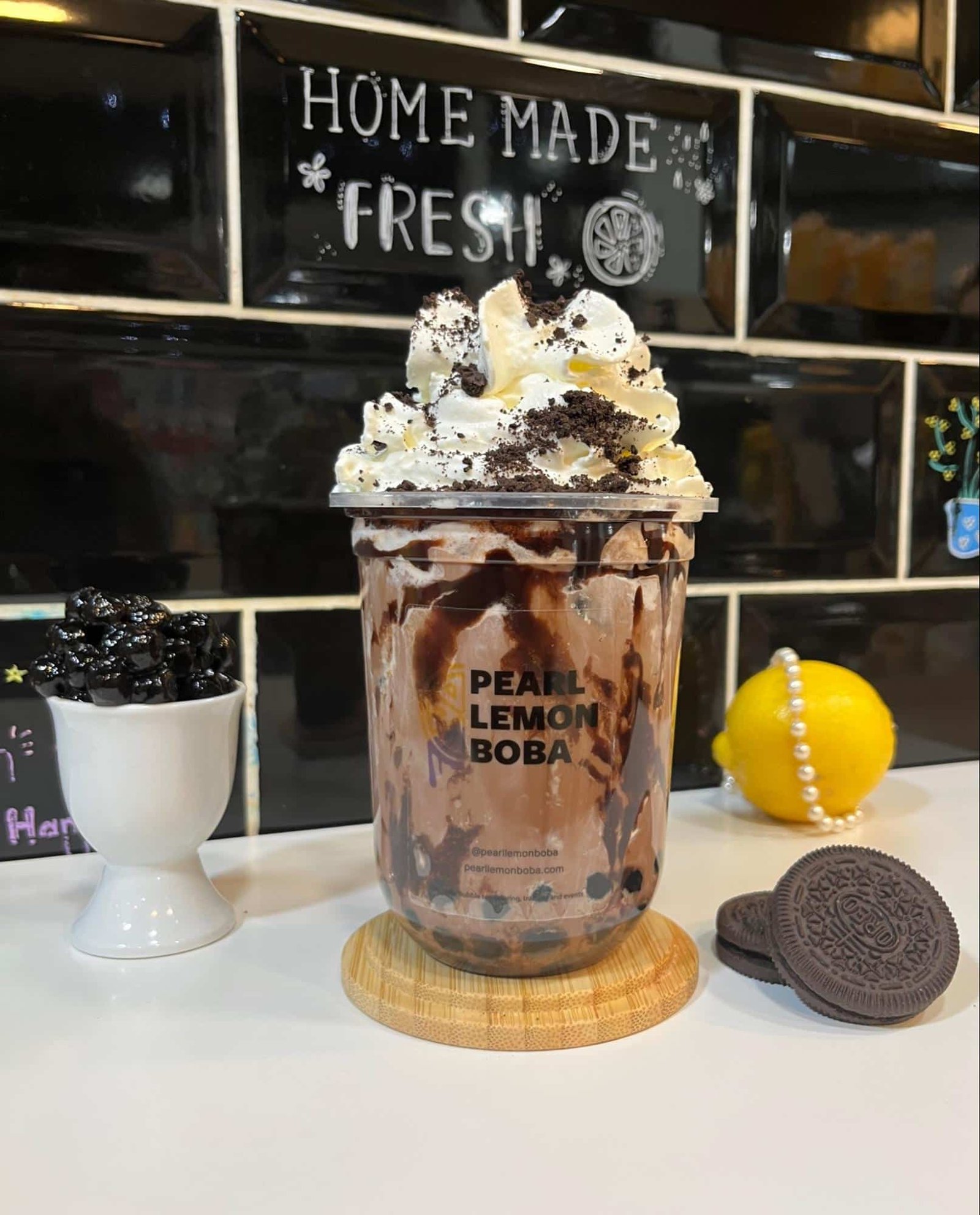
Part of the boba menu design also included putting a focus on quality as well. Most boba products have instructions, but we felt we could do better. We played with cook time for the pearls, how much to make per batch and more. We also tested how much boba powder was made for the perfect taste and colour without being overbearing. Based on our reviews it worked.
We also couldn’t forget adding milk alternatives. So aside the standard skim milk and 2%, we also opted for oat, soy, coconut and almond milk. This was to keep the menu allergen-friendly and more inclusive. We also didn’t charge extra for milk alternatives like most other shops. Even though some shops charge an extra .50 per cup, we felt it would be better to include it in the price. This way, no customer felt taxed due to an allergy or intolerance. This also leads to alot of happy people.
Progress
As we set the groundwork for Pearl Lemon Boba, our focus was divided between the procurement of internal items and the physical setup of the café. Our procurement director took the lead in sourcing the necessary interior items while we brought in contractors to begin the design and construction work. Having previously worked with these contractors, we found the process smoother and more streamlined than anticipated.
The renovation work included installing new flooring, painting the walls, and setting up shelving. We aimed to source materials and furniture locally wherever possible, leading us to rely on Ikea for a significant portion of the interior furnishings, alongside other local suppliers. This approach supported local businesses and helped us maintain our commitment to sustainability and community involvement.
Externally, we focused on giving the café a vibrant and welcoming appearance. The shutter was painted, and banners announcing the opening of Pearl Lemon Boba were displayed prominently. A highlight of our external makeover was the collaboration with a local artist who took on the project of decorating our shutters. His work not only added a unique artistic flair to the café but also integrated it into the local streetscape. The artist worked efficiently, and the final result was nothing short of spectacular, embodying the essence of our brand and creating an inviting atmosphere for our future customers.
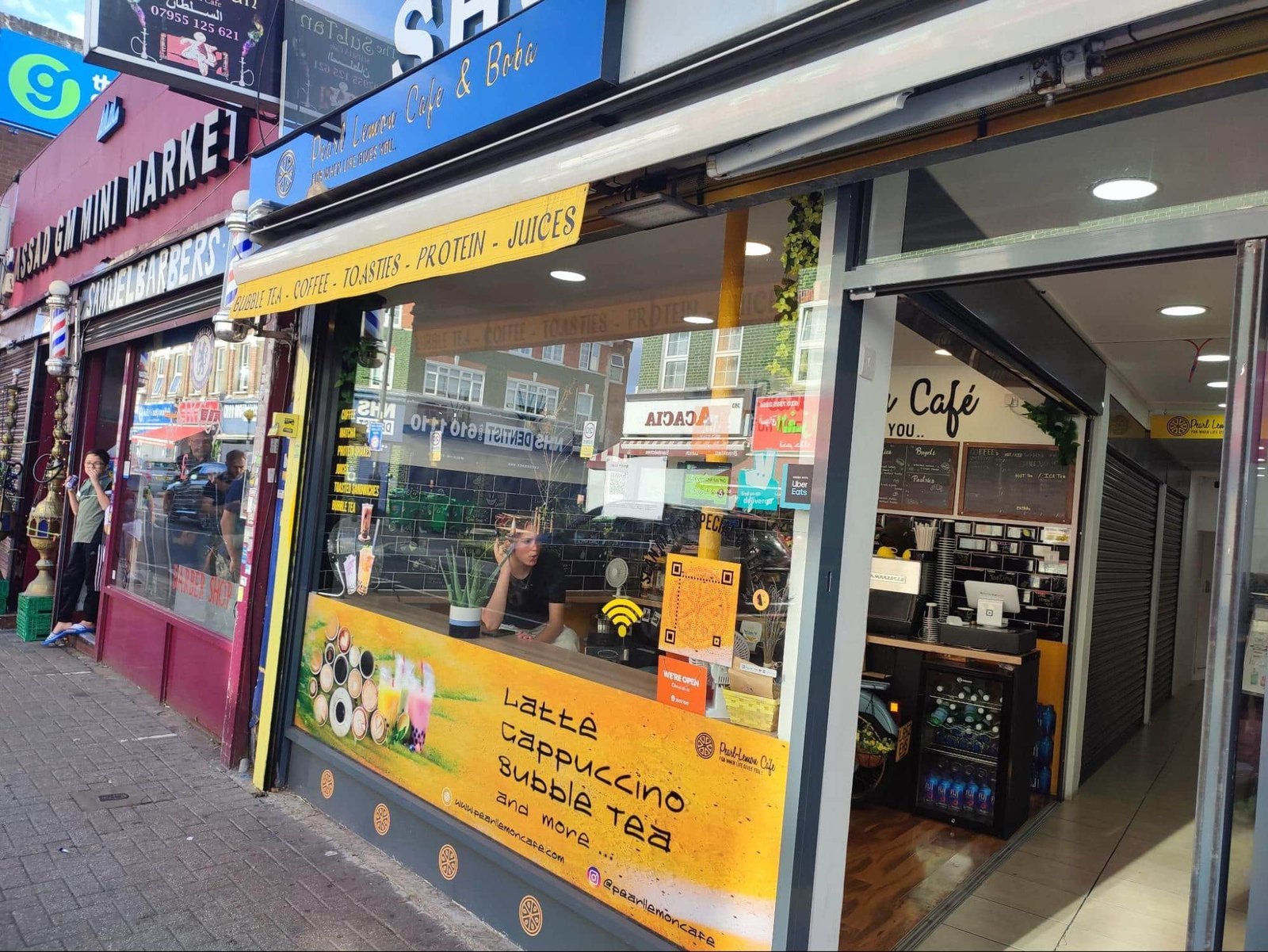
Hiring and Training
When building and designing Pearl Lemon Boba, we knew hiring the right team would be crucial to providing exceptional customer service. We placed advertisements to monitor HR and direct candidates to Deepak and Axel. We were looking for individuals with lively personalities, as this was a non-negotiable requirement for us.
Initially, we faced challenges retaining employees. Some individuals who already held multiple jobs would fail to show up after a few days and demonstrate a lack of interest in the position. However, we didn’t let this discourage us. Instead, we re-evaluated our hiring process and focused on finding candidates committed to the job.
Training was also a significant undertaking for us. We had to start from scratch with 100% of our team members. Many of our staff opted to work across both sides of the business, allowing a seamless transition between locations or a single staff member assigned to each side.
On the bubble tea side of the business, we had to develop our own manuals and procedures due to the distinct equipment used compared to the cafe side. This included online courses covering opening/closing procedures, shop management, customer service, and more. Supporting documents, including video training, recipes, and ingredient cards, were also provided to assist the staff in addressing any queries.
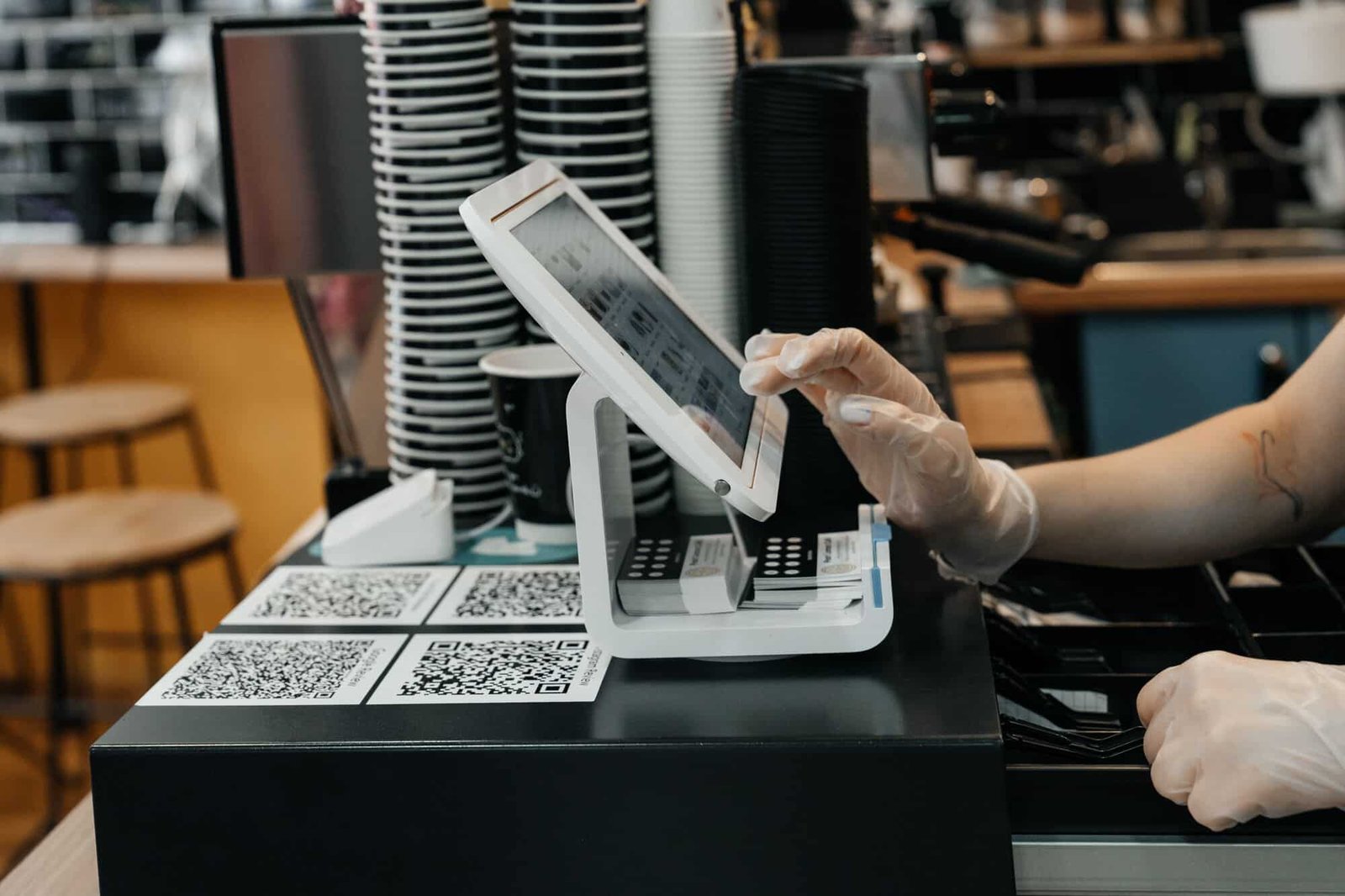
Our video training modules were specifically designed to teach the team how to create various drinks, master making perfectly mixed milk tea, serve takeaway beverages, and attend to customers staying in the cafe. The training also emphasised customer service, covering aspects like soliciting reviews and fostering a lively atmosphere. Furthermore, the videos comprehensively documented all the recipes, ensuring that regardless of individual preferences, the team could learn and master all the necessary skills to become the best in their field.
We implemented the Square system to streamline operations due to its seamless synchronization and user-friendly interface. The platform offered a secure environment, ease of use and customization, and reasonably priced equipment bundles that catered to our needs. Overall, our dedication to assembling a skilled and energetic team and providing comprehensive training has been instrumental in the success of Pearl Lemon Boba.
The Legal Stuff
Legal “stuff” was a long, detailed process to go through. It was mission-critical not to miss anything to avoid delays in our grand opening or risking the potential of being shut down. Pearl Lemon Boba had the benefit of sharing a building with our cafe so we just had to take a few hours per food license “task” to adjust and add things where needed. The first was applying for a food license. This meant:
- at least one person needed a level 3 food hygiene certification (this took 5 hours per person). A Manager needs to have level 3, but the rest of the staff don’t technically need one as it’s assumed they are taught. We got a staff member per location to have a level 3, and then all other staff members had a level 2.
- We needed public liability insurance (this meant hunting and getting quotes) We had a tough time with this as we did catering, so we needed close to 1 million in coverage for public liability due to serving food.
- We had to build a fire safety analysis (to prove we were safe). This was a surprisingly tough document to build as we had to show that everything was up to code and fully mapped out.
4. We had to build a HACCP (this over 50-page document was built to show we can handle any issue or potential hazard, from mould to spoilage to fire or flood). This took close to a week to fully build, and that was with a template guiding us. If there could be a contaminant, we had to list what it was, how it could happen, and how to prove and handle the situation—from chemicals to glass to illness and everything in between.
5. Prove we have a waste and rubbish contract. This was simple and most of the time was spent finding the best price for the best service. But again lucky for us, same building but different units, so they got to share one contract.
We had the huge benefit of working with someone at the council. We could make light modifications to our first application and have it cover the second location because it was in the same building.
Delivery Platforms
Other legal items that came next were registering our logo as a trademark so no one could pretend to be us, going through alcohol license courses and tests (this one was another two-week process) and getting a premises license to serve alcohol.
Setting up Pearl Lemon Boba on delivery platforms was crucial to our marketing strategy. As a new business, we knew that we couldn’t solely rely on foot traffic to bring people in. This meant we had to rely on delivery platforms to get us online visibility. We chose Deliveroo and Just Eats as our delivery partner platforms.
The initial application process for each platform was relatively straightforward. We had to fill in general questions like name, contact information, and restaurant information. However, the real challenge came when we had to turn our menu into a spreadsheet to show price, description, item name, and any modifiers. This took a few days to build, but it was done once it was done.
Our menu took longer to build because there were so many options and modifiers that we had to be sure everyone could customize their drink to their liking. For example, in the cafe, we had a latte; people got one of two sizes, hot or cold, and a milk type. Boba had three sweetness levels, three ice levels, two cup sizes, a topping to choose from, and additional modifiers like adding espresso. These slight differences made it so we spent an extra two days to get it built out.
Once our menu was complete, we sent it as a package to each respective account manager assigned to us. The delivery platforms maintained an ongoing project through year one- experimenting with ads and offers, changing descriptions and photos, and making bundle deals. We invested much time and energy into this portion of the project to gain as many new and recurring customers as possible.

Creating the perfect restaurant listing on delivery platforms turned out to be a precise science that required significant attention to detail and an understanding of what resonates with online customers. We dedicate around 80 hours per platform to fine-tuning every listing element to develop our “secret sauce.” This meticulous process involved crafting descriptions that captured the essence of Pearl Lemon Boba, setting prices that reflected value for money, selecting visually appealing images, and managing reviews to build trust with potential customers. Each factor played a crucial role in optimizing our online presence.
The challenge was daunting but ultimately rewarding. Fine-tuning our listings perfectly allowed Pearl Lemon Boba to stand out on these crowded platforms. The impact of this effort was clear: by establishing a compelling and accessible presence on delivery platforms, we significantly broadened our reach, attracting new customers while keeping our existing base engaged. This strategy enhanced our online visibility and contributed to our overall growth and brand recognition.
Investing in optimising delivery platform listings proved to be a pivotal aspect of our marketing strategy. It underscored our commitment to meeting customers where they are and offering them a seamless, enticing digital experience. The success of this approach reaffirmed our belief in the importance of adaptability and attention to detail in the competitive food delivery market.
Inventory and Stock Management
One of the biggest research projects we had to undertake was determining what equipment and consumables we needed.
The further we got, the more we realized we needed more. We knew we needed an ice machine, but we ended up needing so much more that we had to get one that could go under the counter.
Once we figured out all the large equipment, it was onto the small “here and there” things. This included temp logs, various storage containers, spoons and other washable items for staff to use, backup pumps for syrups and more. The list ended up feeling endless, but we did it.
From Amazon to Nisbets to Ikea, we got everything we needed to have a fully functioning cafe that kept everything safe at all temperatures and stored safely.
To give you a feel for what we had to purchase:
- Ice maker (initially something small because not many people ever wanted ice)
- Under the counter ice maker (a heatwave hit, and our smaller machine could no longer handle what was needed)
- Fridge (all of our milks and one for all of our bottled water)
- Freezer (for ice and longer-term storage)
- Blender (for smoothies and blended drinks)
- Cupboards
- Chairs
- Cleaning supplies
- Mop
- Boba shaker
- Boba Sealer
- Cups/lids/straws
- And more…way more
Then there was the consumables:
Starting with supplier relationships (we wanted the best prices so Lydia had to undergo a heavy negotiation process)
- Milk suppliers
- Boba pearls
- Boba powder
- Boba syrups
- Teas
- To go supplies for drinks
- Juices
- And more
- Once we established everything we needed and had. We built a purchasing spreadsheet to start while we honed in on who was best.
Choco swooped in to save the day making ordering for us way easier as it put it all in one place- no log ins no spread sheets…no nonsense.
Prior to the app, Lydia and Axel worked in one giant shared sheet with a check box system. It seemed the best way to be cohesive with a 5-hour time gap. Lydia would include all the information needed in the sheet. Such as product name, a description, where it was for, where it was from, the cost and the URL. Axel would then check the sheet when things needed to be ordered, check off a little box, and write how many packs they needed. Lydia would check the sheet at her EOD and order for the next day or within 48 hours. As we got busier and expanded, this became hard to manage, and other team members requesting items wouldn’t use the sheet. So choco was a definite lifesaver- it is on our
The internal team was quick to establish a purchasing protocol with Lydia. After a few weeks of watching inventory, a rhythm was built so that when an item had a week left, Lydia would order it and have it delivered in about 72 hours, so there would be no excess stock.
We found that storage space in a small unit became a huge issue with so many materials to order. We did what we could with cupboards, but especially when catering enquiries came in, we had to find a storage space to rent to hold various supplies.
We are still on some wait lists should something come up, but storage is in short supply.
Marketing Efforts- Online and Offline
Marketing cannot be forgotten in our shop’s set-up.
We made offline and online efforts to ensure we hit the ground running. Marketing work began before a physical location was found. This was an absolute must to try to rank the competition out as we opened to try to convert as many people to become our loyal customers.
We developed a website, created social media accounts, and listed ourselves in directories to achieve this. Once these foundations were laid, we initiated
SEO efforts to enhance our visibility on Google and establish an active online presence.
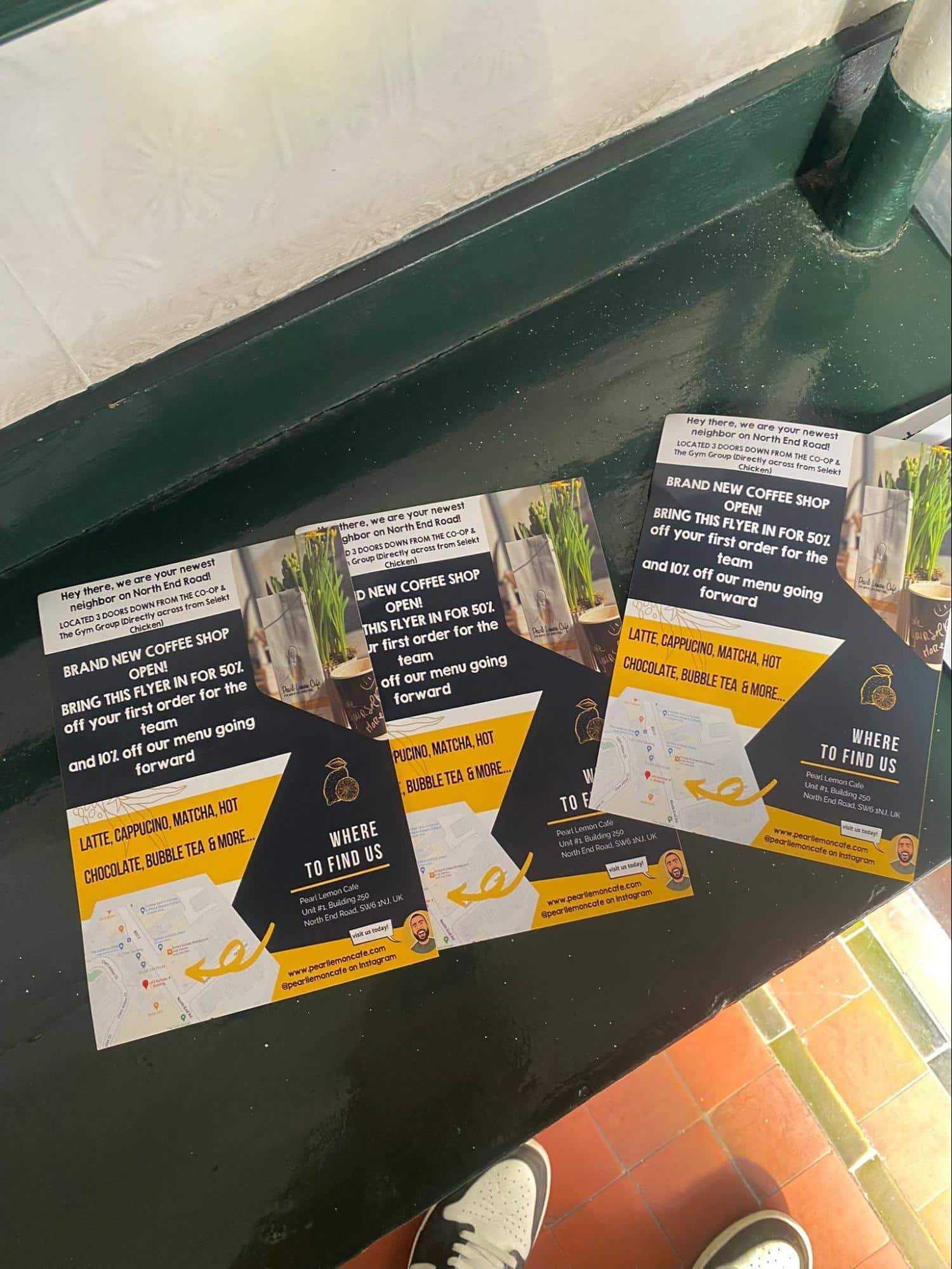
Marketing cannot be forgotten in our shop’s set-up.
We made offline and online efforts to ensure we hit the ground running. Marketing work began before a physical location was found. This was an absolute must to try to rank the competition out as we opened to try to convert as many people to become our loyal customers.
We developed a website, created social media accounts, and listed ourselves in directories to achieve this. Once these foundations were laid, we initiated
SEO efforts to enhance our visibility on Google and establish an active online presence.
Simultaneously, we undertook a local marketing campaign by distributing flyers across Fulham to increase our visibility within the community while our online strategy took effect. We strategically placed flyers in car parks, mailboxes, gyms, and bulletin boards to ensure our presence was noticeable. Additionally, we emphasized the importance of customer reviews and incentivized referrals through discounts.
Aside from flyering, we also bought loyalty cards. Once we got them in we trained our team to push people to take one home with them. They were a simple buy 9 get the 10th free stamp card. This worked phenomenally in creating repeat customers. we had to order over 5000 loyalty cards in year one.
We also had QR codes at the register to scan for discounts and reviews. This was a simple and engaging way to get people to leave reviews while waiting for their drink to be ready.
Pearl Lemon Boba also placed stickers on the front to advertise milk tea and boba teas as well- this gave us a competitive edge as there was no competition nearby for this drink…this did lead to another location opening as a direct result.
The cross-sell opportunity
Fulham has no shortage of businesses and entrepreneurs, and given Pearl Lemon, as a company that builds websites and ranks them on Google, it opens up a real sales opportunity.
…being able to identify such individuals and, where relevant, offer them our services. Having spent a lot of time sitting in cafes, I have met all sorts of business owners who come in.
Furthermore, this was confirmed by asking a friend at Coffee Underground about how many business owners she sees walk through the doors….
And she said dozens – which validates the plan.
Furthermore, Dee visited the coffee truck on North End Road – Souter Bros. Daniel (one of the two brothers) told him that his brother Stuart had been away for the last two days because he picked up some graphic design work from truck customers.
And that, in general – their coffee truck had been good for his design business.
Thus, it underlines that building websites for local businesses will be possible.

The product opportunity
There are many 6,7, and 8-figure coffee businesses we’ve never heard of out there that have built big businesses by selling their range of coffee beans and paraphernalia. Looking at the local market, it’s clear from the Souter Bros, Coffee Underground, and several other cafes – that one of the bigger aims of their local ‘in-person’ and ‘in-store’ presence is to sell their coffee beans.And having done a quick Google – identifying a brand (once we do taste and quality testing) seems straightforward enough:
There’s a big market for this type of model.
Given that the Pearl Lemon brand with lemons is relatively strong, this can extend to other products such as cups, t-shirts, or otherwise.
Ranking Locally
Developing a comprehensive local marketing matrix proved immensely advantageous in surpassing our competitors. We employed various strategies to achieve this feat, placing an eye-catching A-board on the sidewalk, ensuring it was visible to pedestrians on our street and across from us.
In addition, we conducted extensive research on local businesses and schools, forging partnerships with them for special events. We also embraced numerous loyalty platforms, both virtual and physical, enabling us to extend our reach far beyond what our competitors could achieve.
To enhance our local ranking, we actively engaged with associations and clubs, spreading our name far and wide. Platforms such as Glassdoor, Nextdoor, Yell, Yelp, and others played a pivotal role in granting us exceptional visibility, leading to the rapid growth of a dedicated customer base.
Furthermore, local public relations played a significant role in our successful launch. We pursued maximum visibility by securing coverage in local newspapers, print media, and many online publications.
Reviews, Reviews, Reviews
Developing a comprehensive local marketing matrix proved immensely advantageous in surpassing our competitors. We employed various strategies to achieve this feat, placing an eye-catching A-board on the sidewalk, ensuring it was visible to pedestrians on our street and across from us.
In addition, we conducted extensive research on local businesses and schools, forging partnerships with them for special events. We also embraced numerous loyalty platforms, both virtual and physical, enabling us to extend our reach far beyond what our competitors could achieve.
Deliberate efforts were made to gather reviews on various platforms such as Facebook, Google My Business, Yell/Yelp, TrustPilot, and more. This concerted endeavour resulted in hundreds of five-star reviews spread across multiple platforms.

Our online marketing strategy extended beyond obtaining reviews. We also formulated a specific approach to responding to reviews. By adopting this “industry secret” technique, we fostered customer engagement and bolstered our ranking in local searches.
Our response to reviews was not just a simple “thank you.” We took the time to craft personalized responses that addressed each customer’s concerns or compliments. This helped build a connection with our customers and showed them that we genuinely cared about their experience.
We also made it a point to respond to negative reviews promptly and professionally. We acknowledged the customer’s concerns and offered to make things right. This approach helped us turn negative experiences into positive ones and showed potential customers we were committed to providing excellent service.
In addition to responding to reviews, we used them as a tool for improvement. We analyzed our feedback and changed our menu, service, and overall experience to address any concerns or suggestions.
Our approach to acquiring and responding to reviews was a crucial part of our marketing strategy. It helped us establish ourselves as a top-tier business in the highly competitive food and beverage space and allowed us to attract new customers while retaining existing ones.

Shopify and E-commerce
Something unique we started to develop early on was our Shopify store. Shop.pearllemoncafe.com was developed to sell our coffee and ship it to customers, plus other retail items we sold in store. There was more than this, though. We got our design team heavily involved with Lydia on this project. So, while she spent a week building the website and ensuring the checkout worked and it was functional, the design team started working on a variety of merchandise. This merchandise was to include t-shirts, tote bags and mugs. Each “section” we decided would have up to 10 different designs or slogans repeated across all item types. This way if someone liked “death before decaff” they could get a mug, tote and matching t-shirt to express their support of caffeine fully.

Additionally this store was designed to sell any item that could match with our food & beverage locations. This would later include Pearl Lemon Boba and How Matcha.
After a month of designing and a week of website building, the store was ready for orders and was added to our various sites to buy directly from.
We also enjoyed ordering samples and having a fun photo shoot documenting the project.

Bubble Tea Training
Equally as exciting as launching our ecommerce store, our online marketing efforts and reputation quickly led to other business owners coming to us for bubble tea training. We ended up having close to 10 clients in 6 months. We built training videos and courses from scratch, put together kits, and had them come into the cafe for training days.
This was a great team effort between Deepak, Axel and Lydia. Each recorded hours of videos and built documents to have a fully comprehensive training programme.
Deepak recorded videos on introductions to the business, marketing, finding locations and more in-depth bits on marketing matrices.
Axel recorded videos on menu refinement, recipe building, and how to prepare drinks to order in-store and for pickup.
Lydia recorded videos on setting up with suppliers, legal forms, and anything else related to procurement, purchasing, accounting, and legal procedures.
Hurdles and Obstacles
Suppliers and Equipment:
During the shop set-up, dealing with suppliers and acquiring necessary equipment proved to be the most significant challenge. We encountered issues such as the need to return and reorder large equipment, leading to delays and temporary reliance on local sources for certain items, like ice.
It took a few weeks to find a supplier that offered as many vegan options as we wanted. We wanted everyone to enjoy drinks, so this meant vegetarian, vegan and more. We also opted for this because it meant there would be less nasty things in the mixes and things we opted to use. We wanted healthier options than what people could get from competitors.
One supplier, in particular, created difficulties regarding support and ordering whenever equipment exchanges or servicing were required. Their lack of responsiveness caused disruptions and frustrations.
Another supplier initially appeared successful and offered competitive prices, but after placing two orders, they unexpectedly went out of business. This forced us to completely revamp our ordering process, resulting in higher expenses as we struggled to find another supplier offering the same affordability. The mysterious nature of their pricing left us uncertain about their business practices, but it significantly increased the cost of our purchases by 1.5-2.5 times.
Additionally, upon acquiring our ice machine, we realized that extensive modifications were necessary, requiring the hiring of builders to ensure proper fitting and functionality. This involved cutting into shelving, rearranging equipment, and troubleshooting issues with the machine, occasionally leading to minor complications.

The Heat Wave:
In the summer of 2022, an unexpected heat wave posed challenges for our shop’s setup. Given its open nature, the shop was not designed with sufficient cooling measures, so we had to rely on strategically positioned fans and use available outlets to mitigate the heat. However, due to the heat wave, one of our ice machines broke, resulting in the temporary need to purchase ice locally in large quantities until the machine was replaced.
Deliveroo:While we appreciated a free photography session provided by Deliveroo, the resulting photos turned out to be of poor quality. As a result, after six months, we decided to completely redo all the photos for delivery platforms, recognizing the importance of having appealing visuals for our customers.
We were not a fan of the above.
Developing our “secret sauce” also took weeks of research and work. While they had guides and plenty of guides out there, there simply wasn’t something fully comprehensive regarding what makes a perfect store on the platform.
Lydia eventually ended up cracking the code, but it was definitely a headache while we were working on figuring it out.
Securing the Premises:
Due to the high demand for the space, we faced immense pressure to secure the premises swiftly. To demonstrate our commitment, we negotiated the rental terms by paying six months’ rent upfront, showing good faith in the process.
Upon securing the premises and initiating the licensing process, we discovered an additional requirement for another sink in a confined space to comply with the building codes. Despite the challenges posed by limited space, we managed to meet this requirement, ensuring full adherence to regulations.Furthermore, there was a significant time constraint to open the shop within a three-week timeframe, adding to the urgency and intensity of the preparations.
Premise Challenges:
As winter approached, we encountered significant structural issues that resulted in water leaks. Regrettably, resolving these issues took an extended period, causing delays and inconveniences.In addition, extensive customization work was necessary for fixtures and fittings. Our contractor had to modify new shelves purchased from IKEA to ensure a proper fit. This led to a highly customized location that required tailored solutions to accommodate our specific needs. Our main contractor also proved unreliable as he had to find a ride every time he had to ocme to the cafe which was less than ideal.
The Outcome
Pearl Lemon Boba exceeded our expectations in terms of its aesthetic appeal and overall success. Once the business became established, we witnessed consistent monthly growth of at least 13%. Notably, our growth on the Deliveroo platform surpassed even higher levels month after month.
Shortly after opening, we had the opportunity to cater a bubble tea event for the premiere of “Thor: Love and Thunder,” further showcasing the popularity and demand for our offerings.
However, we made the decision to sell the location to prioritize other projects. The new owners expressed their utmost satisfaction with the shop’s setup, which included an existing customer base and well-established supplier relationships.

